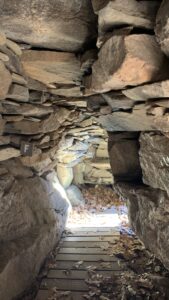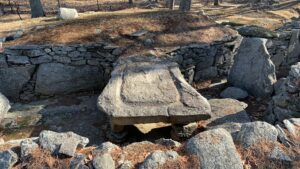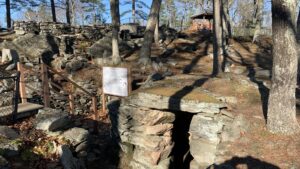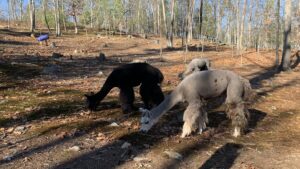By Sandi Barrett, Contributing Writer

Photo/Sandi Barrett
SALEM, N.H. – America’s Stonehenge in Salem, New Hampshire, is an ancient stone village filled with precisely placed boulders reminiscent of England’s Stonehenge. The site is over 4,000 years old and is a collection of man-made chambers, ceremonial spots, and celestial markings. This amazing ruin is more than a simple hike through the woods, it is a journey through history.
The site was originally named Mystery Hill Caves but in 1982 was changed to America’s Stonehenge to reflect the truer meaning of the stone structures. The half-mile hike takes about one to one-and-a-half hours when following along on the audio tour accessed through the America’s Stonehenge app.
Stone structures
The purpose of many of the stone structures is still a mystery. Scientists have named and cataloged the stone formations based on location, orientation, and structural details.
The Watch House located outside the main site is a good example. Its purpose is unclear, however, it is perfectly aligned with the sunrise of February 1, the ancient pagan holiday Imbolc honoring the returning sun god.
Astronomical trail
The astronomical significance of the stone layouts is evident as you progress through the site. Reminiscent of the Wiltshire, England Stonehenge, it is an astronomical calendar and accurate at marking annual solar and lunar events. Fascinatingly, if you draw a line from the viewing platform through the Summer Solstice Sunrise stone it will go directly through one of the trilithons (the classic two vertical stones supporting a horizontal lintel) at England’s Stonehenge.
From the Astronomical Viewing Platform, believed to originally have stone structures imperative to the calendar’s use, you are in the center of a panoramic layout of the astronomical calendar. Sunrise and sunset alignments, including the Summer Solstice Sunrise Stone, Winter Solstice Sunset, Spring Equinox, and Fall Equinox can be seen from the platform.
Radiocarbon dating (carbon-14) at America’s Stonehenge has produced an amazing radio-carbon date of 2,000 B.C.
Stone formations

Photo/Sandi Barrett
One of the most impressive stone formations is the Grooved Table which weighs in at four-and-a-half tons. The massive size of the table was most likely used for ceremonial purposes. It also has a speaking tube positioned under the table giving it a questionable mysteriousness. In the adjacent Oracle Chamber is the other end of the speaking tube. Someone could speak through this end of the tube and a voice would resound under the Grooved Table giving the impression the table is speaking. It is speculated one ceremony performed here was to keep the sun from setting forever.
Inside the Oracle Chamber you will find an ancient carving of an antlered deer, secret niches, and stone seating.
The Pattee area

Photo/Sandi Barrett
The early 19th-century site history includes the Pattee Area. It is the remains of the basement of the Jonathan Pattee family home. Pattee owned the property from 1801 to 1849. He used the various chambers across the site to harbor runaway slaves as part of the Underground Railroad. Manacles found at the site are on display at the visitors center.
Resident alpacas
Six alpacas have called America’s Stonehenge home since 2002. The alpacas are living their best life here. Ashley, Gina, Dixon, Cindy Lou Who, Barnstormer, and Rocky are ready for a photo opp at the end of your hike. In the spring the alpacas are shorn to their summer look to keep them cool. The shorn fibers are available in the store where you will find skeins of yarn and bird nesting kits.

Photo/Sandi Barrett
If you go
America’s Stonehenge is a fascinating walk in the woods. Whether you are on a quest to discover the historical and astronomical significance of the location or on an educational outing with your grandchildren, it is a wonderful place to visit on a beautiful day.
You can learn more about America’s Stonehenge at http://www.stonehengeusa.com/. The audio mobile app tour that takes you through the numbered sites, describing the formations with some interesting history sprinkled into the story.
RELATED CONTENT:
Where to eat, stay, and play for a getaway at Patriot Place (fiftyplusadvocate.com)
Celebrate the Winter Olympics with a visit to Lake Placid (fiftyplusadvocate.com)
Exploring Harvard’s former transcendentalist community (fiftyplusadvocate.com)












